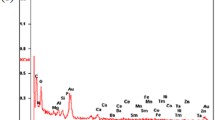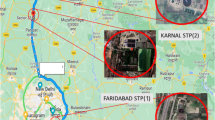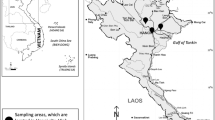Abstract
Limited information about the sludge quality is a major constraint for its usage and proper disposal. This study investigated the occurrence of 49 elements in sludge from 11 wastewater treatment plants (WWTPs) in Chongqing and Xiamen cities of China. The concentration of 46-detected elements ranged from 16.2 μg kg−1 (Pt) to 55.0 g kg−1 (Al) on dry solid basis in the sludge. The enrichment factor of most of the elements was > 1.5, indicating their possible anthropogenic origin. The precious metals had considerably higher enrichment factor ranging from 56.3 to 200,000. Principal component analysis clustered the samples from Chongqing and Xiamen separately to suggest strong spatial variations. Contamination factor, pollution loading index, and integrated pollution degree were calculated to evaluate the elemental pollution risk. The pollution loading index indicated unpolluted to highly polluted levels of the elements in the sludge. In addition, results from the ecotoxicological risk index showed an individual low to very high ecotoxicological risk posed by eight metal(loid)s (As, Cd, Cr, Cu, Mn, Ni, Pb, and Zn) in the WWTPs.




Similar content being viewed by others
References
Abrahim GMS, Parker RJ (2008) Assessment of heavy metal enrichment factors and the degree of contamination in marine sediments from Tamaki Estuary, Auckland. New Zealand Environ Monit Assess 136:227–238
Bhuiyan MAH, Parvez L, Islam M, Dampare SB, Suzuki S (2010) Heavy metal pollution of coal mine-affected agricultural soils in the northern part of Bangladesh. J Hazard Mater 173:384–392
Cayumil R, Khanna R, Rajarao R, Mukherjee PS, Sahajwalla V (2016) Concentration of precious metals during their recovery from electronic waste. Waste Manag 57:121–130
Chanpiwat P, Sthiannopkao S, Kim KW (2010) Metal content variation in wastewater and biosludge from Bangkok’s central wastewater treatment plants. Microchem J 95:326–332
Cui J, Roven HJ (2011) Electronic waste. In: Letcher V (ed) Waste: a handbook for management. Academic Press, Boston, pp 281–296
Diallo MS, Kotte MR, Cho M (2015) Mining critical metals and elements from seawater: opportunities and challenges. Environ Sci Technol 49:9390–9399
Dong B, Liu X, Dai L, Dai X (2013) Changes of heavy metal speciation during high-solid anaerobic digestion of sewage sludge. Bioresour Technol 131:152–158
Douay F, Pelfrêne A, Planque J, Fourrier H, Richard A, Roussel H, Girondelot B (2013) Assessment of potential health risk for inhabitants living near a former lead smelter, part 1: metal concentrations in soils, agricultural crops, and homegrown vegetables. Environ Monit Assess 185:3665–3680
Eriksson J (2001) Concentrations of 61 trace elements in sewage sludge, farmyard manure, mineral fertiliser, precipitation and in oil and crops (no. 5159).Swedish Environmental Protection Agency
Feng Y, Zhang Y, Quan X, Chen S (2014) Enhanced anaerobic digestion of waste activated sludge digestion by the addition of zero valent iron. Water Res 52:242–250
Guo W, Liu X, Liu Z, Li G (2010) Pollution and potential ecological risk evaluation of heavy metals in the sediments around Dongjiang Harbor. Tianjin Prog Environ Sci 2:729–736
Håkanson L (1980) An ecological risk index for aquatic pollution control: a sedimentological approach. Water Res 14:975–1001
Islam MS, Ahmed MK, Al-Mamun MH, Hoque MF (2015) Preliminary assessment of heavy metal contamination in surface sediments from a river in Bangladesh. Environ Earth Sci 73:1837–1848
Jin L, Zhang G, Tian H (2014) Current state of sewage treatment in China. Water Res 66:85–98
Luo W, Lu Y, Gisey JP, Wang T, Shi Y, Wang G, Xing Y (2007) Effects of land use on concentrations of metals in surface soils and ecological risk around Guanting Reservoir. China Environ Geochem Health 29:459–471
Luo XS, Yu S, Zhu YG, Li XD (2012) Trace metal contamination in urban soils of China. Sci Total Environ 421–422:17–30
Müller G (1969) Index of geoaccumulation in sediments of the Rhine River. Geojourna l2:108–118
National Environmental Protection Bureau Environmental quality standard for soils. GB 15618–1995, 1995
National Standards of People’s Republic of China. Control standards for pollutants in sludges from agricultural use. GB 4284–84. http://www.testrust.com/update/news/info/20151116_082513.pdf (accessed on 18/12/2017)
NBSC (National Bureau of Statistics of China) (2013) China statistical yearbook (2013). China Statistics Press, Beijing, China (in Chinese)
Östman M, Lindberg RH, Fick J, Björn E, Tysklind M (2017) Screening of biocides, metals and antibiotics in Swedish sewage sludge and wastewater. Water Res 115:318–328
RodríguezMartín JA, Ramos-Miras JJ, Boluda R, Gil C (2013) Spatial relations of heavy metals in arable and greenhouse soils of a Mediterranean environment region (Spain). Geoderma 200–201:180–188
Romero LJ and McCord AS (2012) Rare earth elements: procurement, application, and reclamation, p8. http://prod.sandia.gov/techlib/access-control.cgi/2012/126316.pdf (accessed on 18/12/2017)
Rudnick RL and Gao S (2003) The composition of the continental crust, pp. 1-64. In The Crust (ed. R.L. Rudnick) Volume. 3, Treatise on Geochemistry (eds. H.D. Holland and K.K)
Singh A, Sharma RK, Agrawal M, Marshall FM (2010) Health risk assessment of heavy metals via dietary intake of foodstuffs from the wastewater irrigated site of a dry tropical area of India, Food Chem. Toxicology 48, 611–619
Suanon F, Sun Q, Dimon B, Mama D, Yu C-P (2016) Heavy metal removal from sludge with organic chelators: comparative study of N, N-bis(carboxymethyl) glutamic acid and citric acid. J Environ Manag 166:341–347
Suanon F, Sun Q, Yang X, Chi Q, Mulla IS, Mama D, Yu C-P (2017) Assessment of the occurrence, spatiotemporal variations and geoaccumulation of fifty-two inorganic elements in sewage sludge: a sludge management revisit. Sci Report 7:5698
Sun Q, Li M, Ma C, Chen Q, Xie X, Yu C-P (2016) Seasonal and spatial variations of PPCP occurrence, removal and mass loading in three wastewater treatment plants located in different urbanization areas in Xiamen, China. Environ Pollut 208:371–381
Taylor SR (1964) Abundance of chemical elements in the continental crust: a new table. Geochim Cosmochim Acta 28:1273–1285
Tomlinson DL, Wilson JG, Harris CR, Jeffrey DW (1980) Problems in the assessment of heavy-metal levels in estuaries and the formation of a pollution index. Helgoländer Meeresun 33:66–575
Upadhyay N, Clements A, Fraser M, Herckes P (2011) Chemical speciation of PM2.5 and PM10 in south Phoenix, AZ. J. Air Waste Manage. Assoc 61, (3), 302–310
USEPA (1995) A guide to the biosolids risk assessments for the EPA part 503 rule; U.S. Environmental Protection Agency: Washington, DC, September, 1995; p 144
USEPA 3051A (2007) Microwave assisted acid digestion of sediments, sludge, soils, and oils. https://www.epa.gov/sites/production/files/2015-12/documents/3051a.pdf (Accessed on 18/12/2017)
Westerhoff P, Lee S, Yang Y, Gordon G, Hristovski K, Halden R, Herckes P (2015) Characterization, recovery opportunities, and valuation of metals in municipal sludges from U.S. wastewater treatment plants nationwide. Environ Sci Technol 49(16):9479–9488
Wong JWC, Selvam A (2006) Speciation of heavy metals during co-composting of sewage sludge with lime. Chemosphere 63:980–986
Wu Q, Cui Y, Li Q, Sun J (2015) Effective removal of heavy metals from industrial sludge with the aid of a biodegradable chelating ligand GLDA, J. Hazard. Mater.283, 748-754
Yang G, Fan M, Zhang G (2014) Emerging contaminants in surface waters in China short review. Environ Res Lett 9:074018
Yang G, Zhang G, Wang H (2015) Current state of sludge production, management, treatment and disposal in China. Water Res 78:60–73
Ye X, Guo X, Cui X, Zhang X, Zhang H, Wang MK, Qiu L, Chen S (2012) Occurrence and removal of endocrine-disrupting chemicals in wastewater treatment plants in the three gorges reservoir area, Chongqing, China. J Environ Monit 14:2204–2211
Yearbook of Chongqing (2011) http://www.cqtj.gov.cn/tjnj/2011/yearbook/indexxls.htm (accessed on 18/11/2016)
Yearbook of Xiamen Special Economic Zone, 2011. http://www.stats-xm.gov.cn/2011/ (accessed on 14/11/2016)
Yessoufou A, Ifon BE, Suanon F et al (2017) Rare earth and precious elements in the urban sewage sludge and lake surface sediments under anthropogenic influence in the Republic of Benin. Environ Monit Assess 189(2017):625
Zhang G, He J, Zhang P, Zhang J (2009) Ultrasonic reduction of excess sludge from activated sludge system II: urban sewage treatment. J Hazard Mater 164:1105–1109
Acknowledgements
The authors would like to appreciate the technical support from Mr. YiJun Yan and the sampling support from Prof. Shaohua Chen.
Funding
This work was funded by the STS Project of Fujian-CAS (2016T3004), China Postdoctoral Science Foundation, Chinese Academy of Sciences-The World Academy of Sciences (CAS-TWAS) president’s fellowship program for developing countries, and Youth Innovation Promotion Association CAS (2016280).
Author information
Authors and Affiliations
Corresponding author
Ethics declarations
Conflict of interest
The authors declare that they have no conflict of interest.
Additional information
Responsible editor: Philippe Garrigues
Electronic supplementary material
ESM 1
(DOCX 76 kb)
Rights and permissions
About this article
Cite this article
Suanon, F., Chi, Q., Yang, X. et al. Diagnosis and ecotoxicological risk assessment of 49 elements in sludge from wastewater treatment plants of Chongqing and Xiamen cities, China. Environ Sci Pollut Res 25, 29006–29016 (2018). https://doi.org/10.1007/s11356-018-2888-z
Received:
Accepted:
Published:
Issue Date:
DOI: https://doi.org/10.1007/s11356-018-2888-z




